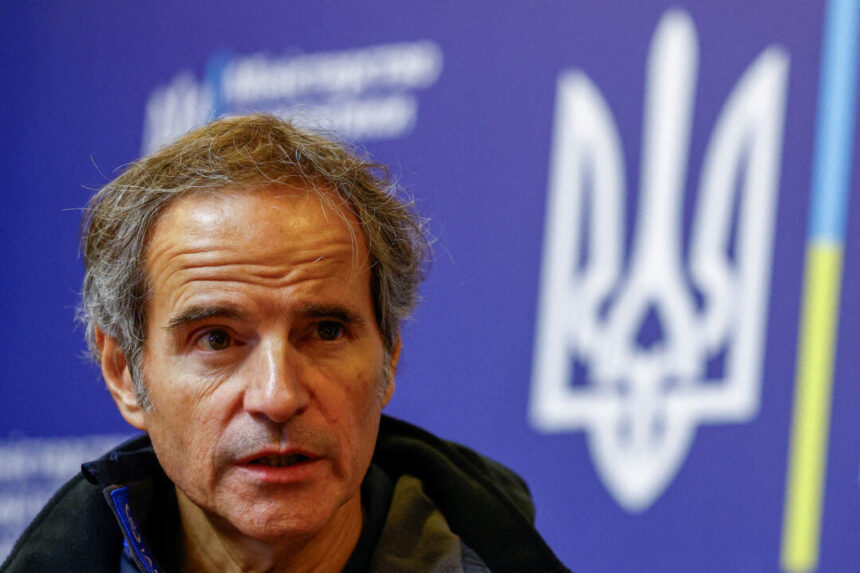Moscow stated that its forces are currently ‘mopping up’ the besieged border region while Kyiv reports new territorial gains.
Rafael Grossi, the head of the International Atomic Energy Agency (IAEA), visited a nuclear plant in Russia’s Kursk region where Ukrainian forces have been engaged in a cross-border offensive.
Moscow claims that the Soviet-era nuclear plant has been targeted multiple times by Ukrainian forces since the start of the cross-border offensive on Aug. 6, resulting in the seizure of a portion of Russia’s western Kursk region.
“The safety and security of nuclear facilities must not be compromised under any circumstances,” said Grossi before his visit to Kursk on Aug. 27. “The safety and security of all nuclear power plants is a central and fundamental concern for the IAEA.”
Reports indicate that fighting in the border region is happening just 25 miles from the nuclear plant.
Russian President Vladimir Putin recently accused Ukrainian forces in the region of attempting to attack the nuclear plant.
“The enemy tried to launch strikes at the nuclear power plant. The [IAEA] has been informed,” Putin said, according to the Russian state-owned TASS news agency.
No documentary evidence was provided for this claim, made during a meeting of high-ranking Russian officials on Aug. 22.
While Kyiv has not yet responded to the accusation of attempting to attack the facility, Russia invaded large parts of eastern and southeastern Ukraine in 2022.
Since then, concerns over the safety of nuclear plants in or near conflict zones have been raised internationally.
Moscow and Kyiv have previously accused each other of attacking a nuclear plant in Zaporizhzhia, one of the four Ukrainian regions invaded and annexed by Russia two years ago.
Prior to his visit, Grossi emphasized that the only way to evaluate the security of Kursk’s nuclear plant, operated by Rosatom, Russia’s state nuclear corporation, was through a visit to the facility.
Following his arrival in Kursk, Grossi was seen on Russian state television discussing with Russian officials at the nuclear plant.
In earlier statements, the IAEA chief had warned of the potential catastrophic consequences if nuclear plants near the conflict zone were targeted by either side.
In 1986, the Soviet-run Chernobyl nuclear plant in northern Ukraine witnessed what is widely regarded as the worst civilian nuclear disaster in history.

The Zaporizhzhia Nuclear Power Plant outside Enerhodar in the Zaporizhzhia region, Ukraine, on Sept. 2, 2022. International Atomic Energy Agency/Handout via Reuters
Claims of Progress by Both Sides
Russian military officials assert that Russian forces are currently in the process of reclaiming Ukrainian territorial gains in Kursk.
On Aug. 27, Apty Alaudinov, a senior Russian Defense Ministry official, announced that Russian forces had driven out Ukrainian troops from two settlements in the border region.
“This area has been cleared, and control has been established,” he stated in a video message shared on the Telegram platform.
Alaudinov reiterated Russian assertions that Ukrainian forces in Kursk were suffering significant losses.
Previously, Kyiv claimed that its forces had taken control of over 450 square miles of territory and numerous settlements in Kursk.
President Volodymyr Zelenskyy mentioned on Aug. 25 that his forces had advanced an additional 2 miles into the region, gaining control of two more settlements.
Ukrainian officials initially stated that the offensive, ongoing for weeks, aimed to strengthen Kyiv’s position ahead of potential cease-fire negotiations.
Later, they explained that the offensive was intended to establish a “buffer zone” in the area to prevent Russian cross-border attacks on Ukraine’s Sumy and Kharkiv regions.
Moscow claimed that the primary objective of the offensive was to capture or disable Kursk’s nuclear power plant, which supplies electricity to 19 regions of Russia.
The claims made by both sides have not been independently verified by The Epoch Times.
Reuters contributed to this report.
Please rewrite the following sentence: “The cat chased the mouse around the house.”
Source link







